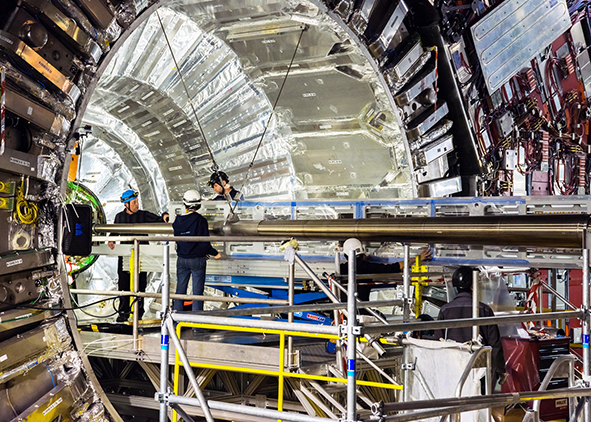CERN. Multiscalar Paradigm
DOI:
https://doi.org/10.19229/2464-9309/762020Keywords:
science, complexity, structure, system, laboratoryAbstract
The multiscalar issue is interpreted here as an essential principle of the mechanics of the project. Each scale, even if taken individually, must be considered within a reference system that is coherent not only based on a series of quantitative and conventional starting principles but even more than a general logic composed of the totality of the scales involved. The contribution – focused on the structures of the European Organization for Nuclear Research (CERN) in Meyrin – aims to investigate the issue of ‘scales’ by looking at the multiscalar project as a creator of a ‘difficult unit’, composed through a ‘structure’ «[… ] as to how things become intelligible» (Forty, 2012, p. 283). CERN, an extraordinary inescapable machine, represents a paradigmatic case on the issue of the multiscalar project.
Downloads
Article Metrics Graph
References
Alexander, C. (1976), “Da un insieme di forze a una forma”, in Los, S. (ed.), L’organizzazione della complessità, Il Saggiatore, Milano, pp. 117-138.
Allegri, D. (2015), “Piattaforma peri-urbana strategica – Modelli e tecnologie per la valorizzazione di paesaggi complessi | Strategic peri-urban platform models and technologies for the improvement of complex landscapes”, in Techne | Journal of Technology for Architecture and Environment, vol. 10, pp. 93-101. [Online] Available at: doi.org/10.13128/Techne-17505 [Accessed 25 April 2020].
Allen, S. (1999), Points + Lines – Diagrams and Projects for the City, Princeton Architectural Press, New York.
Bachman, L. R. (2008), “Architecture and the Four Encounters with Complexity”, in Architectural Engineering and Design Management, vol. 4, issue 1, pp. 15-30.
Capozzi, R. and Visconti, F. (2017), “Il progetto di architettura come nesso tra teoria e prassi | The architectural project as a link between theory and practice”, in Techne | Journal of Technology for Architecture and Environment, vol. 13, pp. 100-108. [Online] Available at: doi.org/10.13128/Techne-19741 [Accessed 30 March 2020].
CERN (2020), Our History. [Online] Available at: home.cern/about/who-we-are/our-history [Accessed 30 March 2020].
Costanzo, D. (2016), “Learning from Venturi – Complexity and Contradiction at 50”, in Architectural Research Quarterly, vol. 20, issue 4, pp. 293-296.
Dottorini, D. (2017), “Lo spazio del reale: l’abitare, il movimento, l’inappropriabile”, in Cinergie – Il Cinema e le altre Arti, n. 10, pp. 72-79. [Online] Available at: doi.org/10.6092/issn.2280-9481/6821 [Accessed 25 April 2020].
Forty, A. (2004), Parole e edifici – Un vocabolario per l’architettura moderna [en. ed. Words and Buildings – A vocabulary of modern architecture, 2012], Pendragon, Bologna.
Gausa, M., Guallart, V., Müller, W., Soriano, F., Porras, F. and Morales, J. (2008), The Metapolis Dictionary of Advanced Architecture – City, technology, society in the information age, Actar, Barcellona.
Hertzberger, H. (2009), Lessons for students in architecture, 010 Publichers, Rotterdam.
Kalb, J. (2014), “Life in Design: Christopher Alexander and the Nature of Order”, in International Journal of Architectural Research, vol. 8, issue 2, pp. 94-98. [Online] Available at: archnet.org/publications/9769 [Accessed 25 April 2020].
Miraglia, M. (2016), “El territorio como unidad de análisis en la historia Ambiental y la geografía histórica | The territory as unit of analysis in Environmental History and Historical Geography”, in Expedições | Teoria da História e Historiografia, vol. 7, n. 2, pp. 40-55. [Online] Available at: www.revista.ueg.br/index.php/revista_geth/article/view/5722 [Accessed 25 April 2020].
Price, B., Kienast, F., Seidl, I., Ginzler, C., Verburg, P. H. and Bolliger, J. (2015), “Future landscape of Switzerland – Risk areas for urbanisation and land abandonment”, in Applied Geography, vol. 57, pp. 32-41. [Online] Available at: doi.org/10.1016/j.apgeog.2014.12.009 [Accessed 25 April 2020].
Rovelli, C. (2014), Sette brevi lezioni di fisica, Adelphi, Milano.
Sanjuán, C. O. (2019), Landscape as Territory, Actar, Barcellona.
Treccani (2020), Paradigma. [Online] Available at: www.treccani.it/vocabolario/paradigma [Accessed 30 March 2020].
Treister, S. (2020), “THUTOAH – The Holographic Universe Theory Of Art History”, in Artnodes, n. 25, pp. 1-8. [Online] Available at: doi.org/10.7238/a.v0i25.3323 [Accessed 12 March 2020].
Tschumi, B. (1996), Architecture and Disjunction, MIT Press, Cambridge (MA).
Venturi, R. (2005), Complessità e contraddizioni nell’architettura [or. ed. Complexity and Contradiction in Architecture, 1992], Edizioni Dedalo, Bari.

Downloads
Published
How to Cite
Issue
Section
License
This Journal is published under Creative Commons Attribution Licence 4.0 (CC-BY).
License scheme | Legal code
This License allows anyone to:
Share: copy and redistribute the material in any medium or format.
Adapt: remix, transform, and build upon the material for any purpose, even commercially.
Under the following terms
Attribution: Users must give appropriate credit, provide a link to the license, and indicate if changes were made; users may do so in any reasonable manner, but not in any way that suggests the licensor endorses them or their use.
No additional restrictions: Users may not apply legal terms or technological measures that legally restrict others from doing anything the license permits.
Notices
Users do not have to comply with the license for elements of the material in the public domain or where your use is permitted by an applicable exception or limitation.
No warranties are given. The license may not give users all of the permissions necessary for their intended use. For example, other rights such as publicity, privacy, or moral rights may limit how you use the material.


















































































